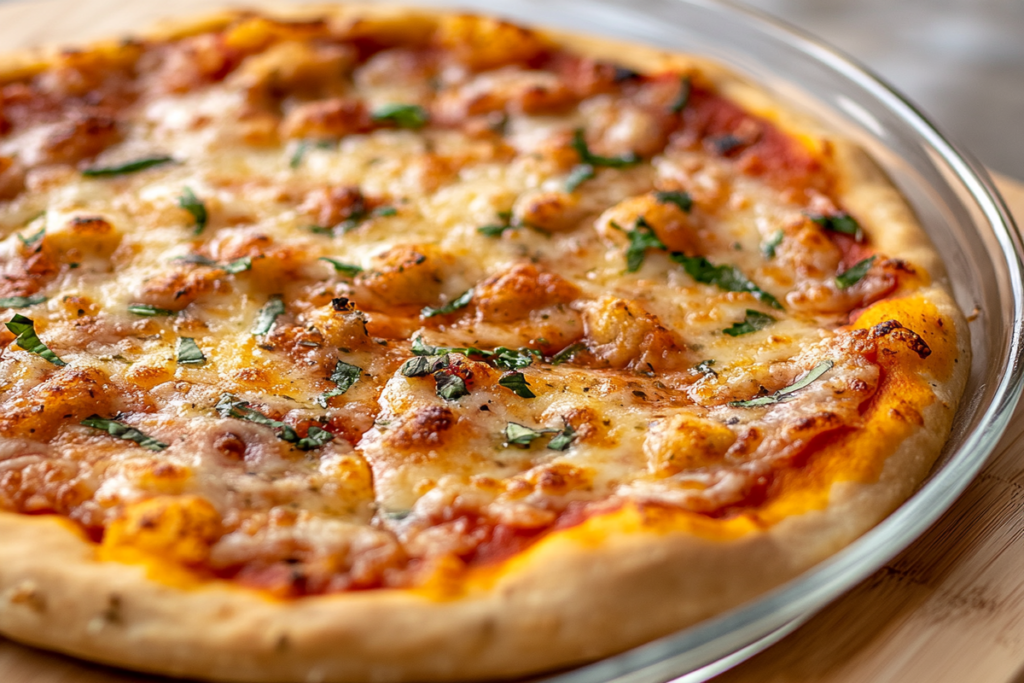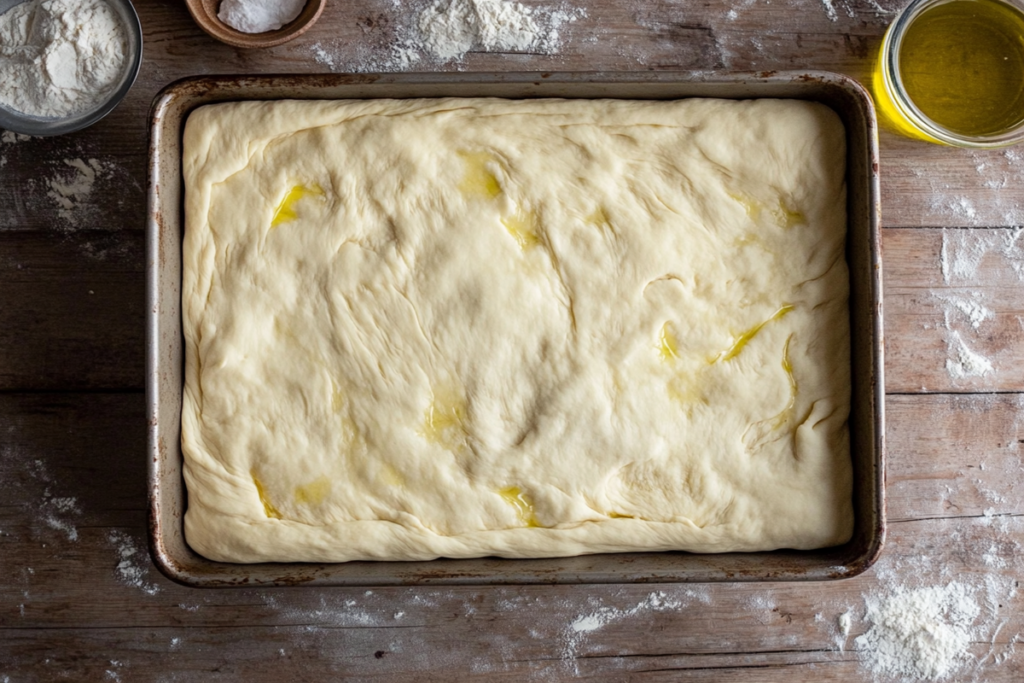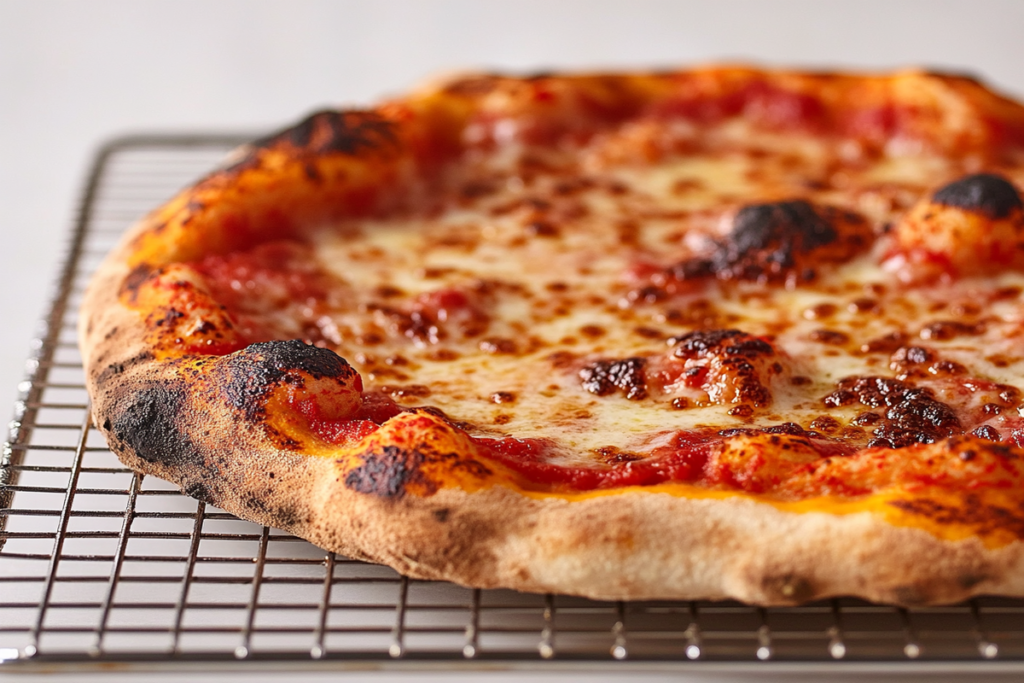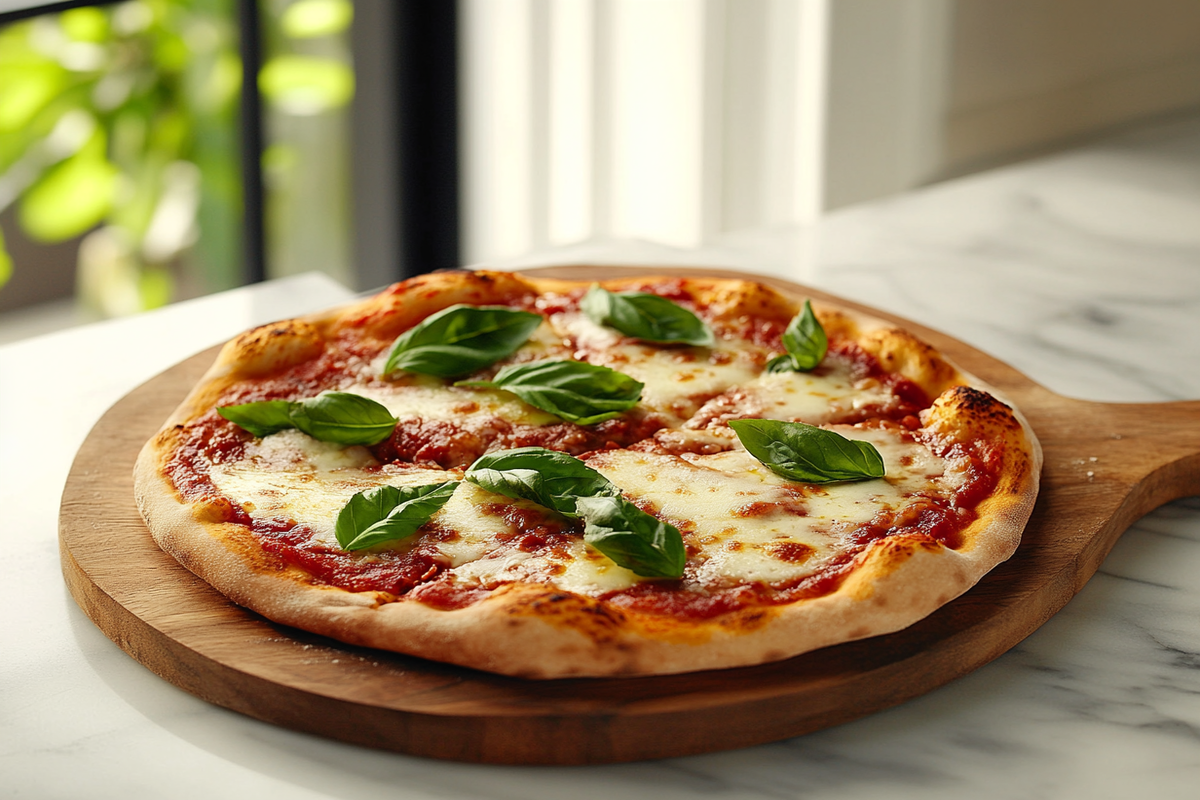Discover the crispy, airy, and utterly delicious world of authentic Roman-style pizza—made easy with a foolproof method!
Roman pizza is one of Italy’s best-kept secrets—light, crispy, and perfect for slicing up and sharing. Unlike its Neapolitan cousin, it bakes in a rectangular pan, giving it a unique crunch and an airy interior. If you’ve ever bitten into a slice of pizza that’s perfectly crisp on the outside but still soft inside, you know exactly why this style is so special.
This recipe is for anyone who craves a homemade pizza that rivals the best Italian bakeries. Whether you’re a seasoned home cook or a beginner, you’ll learn how to create the ultimate Roman pizza with an easy-to-follow technique, a long-fermented dough for deep flavor, and expert tips for that signature crispy bottom.
By the end, you’ll know how to master the dough, choose the best toppings, and bake your pizza to golden perfection. So, let’s roll up our sleeves and get started!
Ingredient Breakdown
For the Dough:
- 500g high-protein flour (Manitoba or bread flour, for better gluten development)
- 375ml cold water (75% hydration for an airy texture)
- 2g dry yeast (or 6g fresh yeast)
- 10g fine sea salt
- 15ml extra virgin olive oil (for a crisp, flavorful crust)

For the Sauce:
- 400g canned San Marzano tomatoes (or any high-quality canned tomatoes)
- 1 tbsp extra virgin olive oil
- 1 garlic clove, minced
- ½ tsp fine sea salt
- ½ tsp sugar (optional, balances acidity)
For the Toppings:
Classic Roman Pizza:
- 150g fresh mozzarella (or fior di latte), torn into pieces
- Fresh basil leaves
- Pecorino Romano, grated
Alternative Variations:
- Pizza Bianca: Olive oil, sea salt, rosemary
- Patate e Rosmarino: Thinly sliced potatoes, rosemary, olive oil
- Mortadella & Pistachios: Ricotta, mortadella, crushed pistachios
If you love simple, flavorful Italian dishes, try our Baked Ricotta Dip as a starter before serving your Roman pizza.
Step-by-Step Instructions
1. Prepare the Dough (24-48 Hours in Advance)
- In a large mixing bowl, combine flour and 80% of the water. Stir until just combined. Let it rest for 30 minutes (autolyse).
- Sprinkle the yeast over the dough and mix gently. Let sit for 5 minutes.
- Add the remaining water gradually, mixing well after each addition.
- Knead by hand for 10 minutes or use a stand mixer on low speed for 8 minutes. The dough should be elastic and slightly sticky.
- Add salt and continue kneading for another 3 minutes.
- Finally, drizzle in the olive oil and knead until fully incorporated. The dough will become smoother.
- Transfer to a lightly oiled bowl, cover with plastic wrap, and refrigerate for 24-48 hoursز
Long fermentation enhances texture and flavor—just like in this expert breakdown on Pizza Dough Fermentation by King Arthur Baking.
For more insights into working with high-hydration doughs, check out our Veggie Stromboli Guide
2. Shape the Dough
- Remove the dough from the fridge and let it rest at room temperature for 2 hours.
- Lightly flour a work surface and turn the dough out.
- Gently stretch and fold the dough once to build strength.
- Transfer it to a well-oiled baking sheet and use your fingertips to press it outward into a rectangle. Don’t force it—if it resists, let it rest for 10 minutes before trying again.
3. Prepare the Sauce
- In a small saucepan, heat olive oil over low heat.
- Add the minced garlic and cook for 30 seconds until fragrant.
- Stir in the canned tomatoes, salt, and sugar.
- Simmer for 10-15 minutes, stirring occasionally, until slightly thickened. Let cool.
4. Preheat the Oven
- Set your oven to 500°F (260°C) and place a pizza stone or steel on the middle rack. Preheat for at least 30 minutes.
5. Assemble the Pizza
- Spread a thin layer of the tomato sauce over the dough, leaving a ½-inch border.
- Scatter the mozzarella evenly over the surface.
- Add any additional toppings, keeping them light to avoid weighing down the dough.

6. Bake the Pizza
- Place the baking sheet directly onto the preheated pizza stone or steel.
- Bake for 12-15 minutes until the edges are golden and crispy.
- If the bottom isn’t crisp enough, transfer the pizza directly onto the stone for another 1-2 minutes.
7. Serve & Enjoy
- Remove from the oven and let the pizza cool for 5 minutes.
- Sprinkle with fresh basil and Pecorino Romano before slicing.
- Serve immediately and enjoy your homemade Roman pizza!
Nutrition Facts
Here’s a general breakdown of the nutrition for one slice (based on an 8-slice rectangular pizza with classic toppings). Actual values may vary depending on ingredients and portion sizes.
| Nutrient | Per Slice (Approx.) |
|---|---|
| Calories | 280 |
| Carbohydrates | 40g |
| Protein | 9g |
| Fat | 8g |
| Sodium | 350mg |
| Fiber | 2g |
Dietary Considerations
- Lower Carb Option: Swap out some of the flour for a blend of almond flour and vital wheat gluten.
- Vegan Alternative: Use dairy-free cheese and a simple garlic-olive oil base instead of tomato sauce.
- Gluten-Free Variation: Replace standard flour with a gluten-free bread flour blend for better structure.

Pro Tips Variations
Dough & Baking Hacks
- Cold Fermentation for Flavor: The longer the dough ferments (24-48 hours), the deeper the flavor and better the texture.
- Hydration is Key: A higher hydration dough (75-80%) creates a lighter, airier crust—don’t skimp on water!
- Crispy Bottom Trick: If your pizza isn’t crispy enough after baking, place it directly on the oven rack for 2 more minutes.
- No Pizza Stone? Use an upside-down baking sheet preheated in the oven to mimic a stone’s heat retention.
Common Mistakes to Avoid
- Overloading Toppings: Too many toppings make the crust soggy and prevent proper crisping. Less is more!
- Not Letting Dough Rest: Skipping the room-temperature rest before shaping results in an unworkable, tight dough.
- Using Cold Cheese: Always bring cheese to room temperature before baking for even melting.
Flavor Variations
Classic Roman Pizzas
- Pizza Bianca: No tomato sauce—just olive oil, sea salt, and rosemary for a minimalist, ultra-crispy pizza.
- Pizza Patate e Rosmarino: Thinly sliced potatoes, rosemary, and olive oil make a perfect, hearty vegetarian option.
- Pizza Mortadella e Pistacchio: A luxurious twist with creamy ricotta, mortadella, and crushed pistachios.
Creative Twists
- Spicy Calabrese: Add thinly sliced spicy salami and drizzle with hot honey after baking.
- Truffle Mushroom: Use a white sauce base with mushrooms, mozzarella, and a drizzle of truffle oil.
- Summer Caprese: After baking, top with fresh cherry tomatoes, burrata, and a balsamic glaze drizzle.
Serving Suggestions & Pairings
Best Side Dishes
- Arugula Salad with Lemon & Parmesan: A bright, peppery salad balances the richness of the pizza.
- Antipasto Platter: Serve with cured meats, olives, and marinated artichokes for a true Italian experience.
- Roasted Garlic Dip: A simple garlic-infused olive oil dip adds extra depth to every bite.
Beverage Pairings
- Wine: A crisp Vermentino or a light Chianti pairs beautifully with the tomato and cheese flavors.
- Beer: A Pilsner or light amber ale complements the crispy crust without overpowering it.
- Cocktails: Try a Negroni or Aperol Spritz for a true Roman dining experience.
Leftover Ideas
- Reheat for Breakfast: Warm up leftovers in a skillet with a lid to keep the crust crispy.
- Roman Pizza Panini: Sandwich two slices together with fresh arugula and prosciutto for a next-day lunch.
- Savory Pizza Croutons: Cube leftover pizza, bake until crispy, and use as crunchy salad toppings.
By pairing Roman pizza with the right sides and drinks, you can create a restaurant-quality meal at home. Whether you’re keeping it traditional or adding your own twist, this pizza is guaranteed to impress!

Why You’ll Love This Recipe
- Crispy Yet Light Texture: Roman pizza delivers the perfect balance—crispy on the bottom, yet airy and tender inside.
- Easy for Home Cooks: No special equipment required—just a baking sheet and a hot oven.
- Make-Ahead Friendly: The long fermentation process means you can prep the dough days in advance.
- Endless Topping Possibilities: Whether you prefer classic Margherita or something bold like truffle mushroom, this pizza adapts to any taste.
- Restaurant-Quality at Home: With simple ingredients and the right technique, you can achieve a pizza that rivals the best Italian bakeries.
To extend the article to the 1900–2200 word range, I suggest adding one or two sections that provide additional value while keeping engagement high. Based on competitor analysis, here are two creative and informative sections that will enhance the article:
- The History & Origins of Roman Pizza – This section gives readers a cultural and historical background, helping them appreciate what makes Roman pizza unique.
- Troubleshooting Common Dough & Baking Issues – A practical section that addresses common mistakes and how to fix them, ensuring readers get perfect results.
The History & Origins of Roman Pizza
Roman pizza isn’t just a meal—it’s a culinary tradition dating back centuries. Unlike Neapolitan pizza, which is deeply rooted in Naples’ street food culture, Roman pizza developed as a bakery specialty, evolving into two main styles:
Pizza al Taglio: The Street Food Staple
In the bustling streets of Rome, pizza al taglio (literally “pizza by the cut”) became a go-to snack for locals. Unlike round, single-serving pizzas, these were baked in large rectangular trays and sold by weight, allowing customers to choose portion sizes. This style became popular because:
- It’s highly adaptable—bakers experimented with endless topping variations.
- It’s quick and convenient—perfect for grabbing a slice on the go.
- It maintains its texture—thanks to a sturdier crust that stays crisp longer.
Pizza in Teglia: The Bakery-Style Classic
This variation, pizza in teglia alla Romana, is the high-hydration, long-fermented version perfected in Roman bakeries. It differs from Neapolitan pizza in several ways:
- Higher hydration (70–80%) gives it a super airy crumb structure.
- Olive oil in the dough enhances crispiness.
- Baking in metal trays helps retain moisture while developing a golden bottom crust.
Today, both styles remain a staple of Roman cuisine, offering a delicious, crispy alternative to traditional wood-fired pizzas. Whether you enjoy a quick slice on the streets of Rome or bake a perfect tray at home, Roman pizza delivers incredible texture and flavor in every bite.
Troubleshooting Common Dough & Baking Issues
Even with the best recipe, making Roman pizza can have its challenges. If you run into problems, here’s how to fix the most common mistakes:
1. Dough is Too Sticky to Work With
Possible Cause: Too much water or insufficient gluten development.
Fix It: Let the dough rest longer before stretching, and use damp hands instead of flour to handle high-hydration dough.
2. Dough Won’t Stretch Properly
Possible Cause: The gluten is too tight from cold fermentation.
Fix It: Let the dough sit at room temperature for at least 2 hours before shaping. If it still resists, cover it with plastic wrap and rest for 10 minutes before trying again.
3. Pizza Crust is Too Hard or Dry
Possible Cause: Overbaking or using too little water in the dough.
Fix It: Ensure the dough has at least 75% hydration and bake at 500°F (260°C) for 12-15 minutes. A drizzle of olive oil before baking can help lock in moisture.
4. Pizza Bottom is Too Soft or Soggy
Possible Cause: Oven isn’t hot enough or too many wet toppings.
Fix It: Preheat your oven and pizza stone for at least 30 minutes before baking. Also, avoid overloading the pizza with sauce or watery ingredients like fresh mozzarella.
5. Uneven Baking (Some Parts Cook Faster Than Others)
Possible Cause: Uneven heat distribution.
Fix It: Rotate the tray halfway through baking and, if needed, finish baking directly on a hot pizza stone or steel for the last 2 minutes.
By keeping these troubleshooting tips in mind, you’ll master the art of Roman pizza—crispy, airy, and full of flavor—every time!
FAQ
What makes a Roman pizza?
Roman pizza is known for its crispy yet airy crust, achieved through high-hydration dough and long fermentation. Unlike Neapolitan pizza, it is rectangular and often baked in a sheet pan, making it perfect for slicing and sharing.
What is different about Romana pizza?
Pizza Romana differs from other styles by using olive oil in the dough for added crispiness. It also has a longer fermentation, resulting in a more complex flavor and better gluten development. Plus, it’s typically baked at a lower temperature than Neapolitan pizza, which cooks in seconds in a wood-fired oven.
How big is a Roman pizza?
Traditional Pizza al Taglio is baked in large trays and sold by weight. At home, a standard Roman pizza is about 12×18 inches, enough to serve multiple people. However, you can adjust the size based on your baking sheet or preference.
What is Roman vs Neapolitan pizza?
Neapolitan pizza is soft, round, and quickly baked in a wood-fired oven at extreme temperatures. Roman pizza, on the other hand, is rectangular, crispier, and uses olive oil in the dough. The longer fermentation also gives it a more structured, chewy texture.
Roman pizza is a game-changer for homemade pizza lovers. With its signature crispy yet airy crust, long-fermented dough, and endless topping possibilities, it’s an easy way to bring authentic Italian flavors to your kitchen. Whether you keep it classic with tomato and mozzarella or explore creative variations like mortadella and pistachios, this recipe guarantees pizzeria-quality results at home.
Now that you’ve mastered this technique, experiment with your own toppings, try different hydration levels, and enjoy the magic of homemade Roman pizza!

